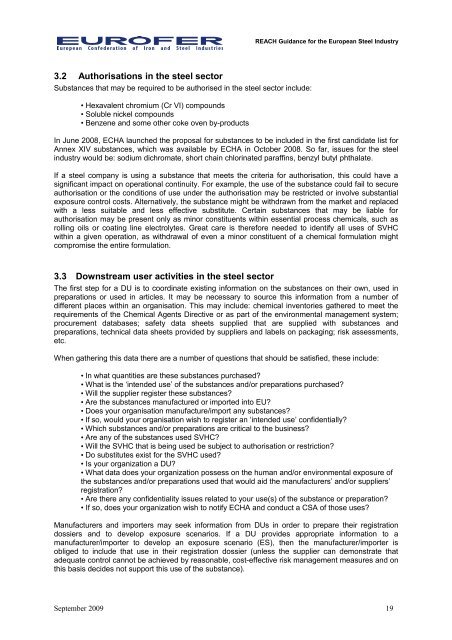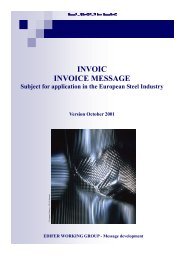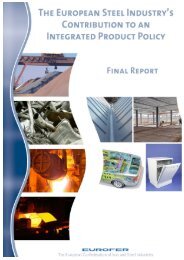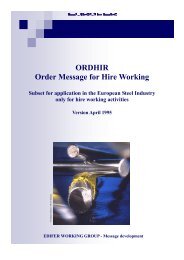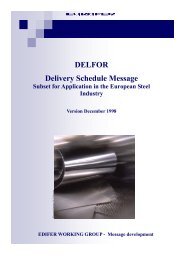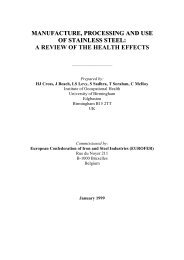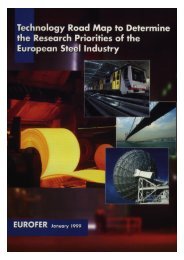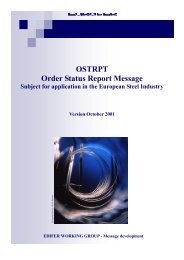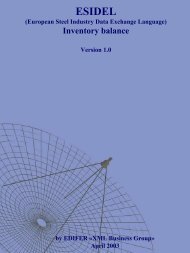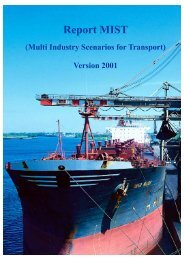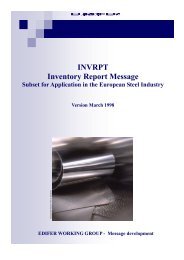EUROFER REACH guidance for the European Steel Industry. 09.09 ...
EUROFER REACH guidance for the European Steel Industry. 09.09 ...
EUROFER REACH guidance for the European Steel Industry. 09.09 ...
Create successful ePaper yourself
Turn your PDF publications into a flip-book with our unique Google optimized e-Paper software.
3.2 Authorisations in <strong>the</strong> steel sector<br />
Substances that may be required to be authorised in <strong>the</strong> steel sector include:<br />
• Hexavalent chromium (Cr VI) compounds<br />
• Soluble nickel compounds<br />
• Benzene and some o<strong>the</strong>r coke oven by-products<br />
<strong>REACH</strong> Guidance <strong>for</strong> <strong>the</strong> <strong>European</strong> <strong>Steel</strong> <strong>Industry</strong><br />
In June 2008, ECHA launched <strong>the</strong> proposal <strong>for</strong> substances to be included in <strong>the</strong> first candidate list <strong>for</strong><br />
Annex XIV substances, which was available by ECHA in October 2008. So far, issues <strong>for</strong> <strong>the</strong> steel<br />
industry would be: sodium dichromate, short chain chlorinated paraffins, benzyl butyl phthalate.<br />
If a steel company is using a substance that meets <strong>the</strong> criteria <strong>for</strong> authorisation, this could have a<br />
significant impact on operational continuity. For example, <strong>the</strong> use of <strong>the</strong> substance could fail to secure<br />
authorisation or <strong>the</strong> conditions of use under <strong>the</strong> authorisation may be restricted or involve substantial<br />
exposure control costs. Alternatively, <strong>the</strong> substance might be withdrawn from <strong>the</strong> market and replaced<br />
with a less suitable and less effective substitute. Certain substances that may be liable <strong>for</strong><br />
authorisation may be present only as minor constituents within essential process chemicals, such as<br />
rolling oils or coating line electrolytes. Great care is <strong>the</strong>re<strong>for</strong>e needed to identify all uses of SVHC<br />
within a given operation, as withdrawal of even a minor constituent of a chemical <strong>for</strong>mulation might<br />
compromise <strong>the</strong> entire <strong>for</strong>mulation.<br />
3.3 Downstream user activities in <strong>the</strong> steel sector<br />
The first step <strong>for</strong> a DU is to coordinate existing in<strong>for</strong>mation on <strong>the</strong> substances on <strong>the</strong>ir own, used in<br />
preparations or used in articles. It may be necessary to source this in<strong>for</strong>mation from a number of<br />
different places within an organisation. This may include: chemical inventories ga<strong>the</strong>red to meet <strong>the</strong><br />
requirements of <strong>the</strong> Chemical Agents Directive or as part of <strong>the</strong> environmental management system;<br />
procurement databases; safety data sheets supplied that are supplied with substances and<br />
preparations, technical data sheets provided by suppliers and labels on packaging; risk assessments,<br />
etc.<br />
When ga<strong>the</strong>ring this data <strong>the</strong>re are a number of questions that should be satisfied, <strong>the</strong>se include:<br />
• In what quantities are <strong>the</strong>se substances purchased?<br />
• What is <strong>the</strong> ‘intended use’ of <strong>the</strong> substances and/or preparations purchased?<br />
• Will <strong>the</strong> supplier register <strong>the</strong>se substances?<br />
• Are <strong>the</strong> substances manufactured or imported into EU?<br />
• Does your organisation manufacture/import any substances?<br />
• If so, would your organisation wish to register an ‘intended use’ confidentially?<br />
• Which substances and/or preparations are critical to <strong>the</strong> business?<br />
• Are any of <strong>the</strong> substances used SVHC?<br />
• Will <strong>the</strong> SVHC that is being used be subject to authorisation or restriction?<br />
• Do substitutes exist <strong>for</strong> <strong>the</strong> SVHC used?<br />
• Is your organization a DU?<br />
• What data does your organization possess on <strong>the</strong> human and/or environmental exposure of<br />
<strong>the</strong> substances and/or preparations used that would aid <strong>the</strong> manufacturers’ and/or suppliers’<br />
registration?<br />
• Are <strong>the</strong>re any confidentiality issues related to your use(s) of <strong>the</strong> substance or preparation?<br />
• If so, does your organization wish to notify ECHA and conduct a CSA of those uses?<br />
Manufacturers and importers may seek in<strong>for</strong>mation from DUs in order to prepare <strong>the</strong>ir registration<br />
dossiers and to develop exposure scenarios. If a DU provides appropriate in<strong>for</strong>mation to a<br />
manufacturer/importer to develop an exposure scenario (ES), <strong>the</strong>n <strong>the</strong> manufacturer/importer is<br />
obliged to include that use in <strong>the</strong>ir registration dossier (unless <strong>the</strong> supplier can demonstrate that<br />
adequate control cannot be achieved by reasonable, cost-effective risk management measures and on<br />
this basis decides not support this use of <strong>the</strong> substance).<br />
September 2009 19


